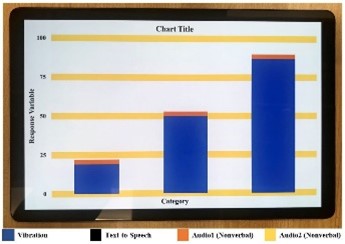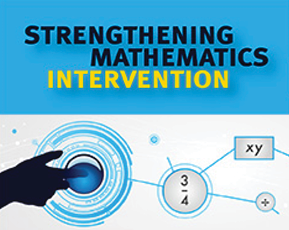The Individuals with Disabilities Education Act (IDEA) requires states to provide special education and related services to eligible students whose school performance is “adversely affected” by one of 13 conditions: specific learning disability (including dysgraphia, dyscalculia, auditory processing disorder, nonverbal learning disability, other health impairment (e.g., ADHD), autism spectrum disorder (ASD), emotional disturbance, speech or language impairment, visual impairment, deafness, hearing impairment, deaf-blindness, orthopedic impairment, intellectual disability, traumatic brain injury, and multiple disabilities. The U.S. Department of Education reports that more than 7 million children and youth (14% of all public school students) were served under IDEA from 2018-19.
This Spotlight features DRK-12 work to address approaches and develop tools to support STEM teaching and learning for students with physical and learning disabilities.
In this Spotlight...
-
- Blog | Building Flexible Modality Layers to Support Inclusive Educational Technologies
- Featured Projects
- CAREER: Bridging the Digital Accessibility Gap in STEM Using Multisensory Haptic Platforms (PI: Jenna Gorlewicz)
- CAREER: Fraction Activities and Assessments for Conceptual Teaching (FAACT) for Students with Learning Disabilities (PI: Jessica Hunt)
- Developing Preservice Teachers' Capacity to Teach Students with Learning Disabilities in Algebra I (PI: Casey Hord)
- Perceptual and Implementation Strategies for Knowledge Acquisition of Digital Tactile Graphics for Blind and Visually Impaired Students (PIs: Nicholas Giudice, Jenna Gorlewicz, Derrick Smith, and Andreas Stefik)
- Promoting Scientific Explorers Among Students with Learning Disabilities: The Design and Testing of a Grade 2 Science Program Focused on Earth’s Systems (PI: Christian Doabler)
- Strengthening Mathematics Intervention: Identifying and Addressing Challenges to Improve Instruction for Struggling Learners (PI: Amy Brodesky)
- Resources
- Additional Projects
Blog | Building Flexible Modality Layers to Support Inclusive Educational Technologies
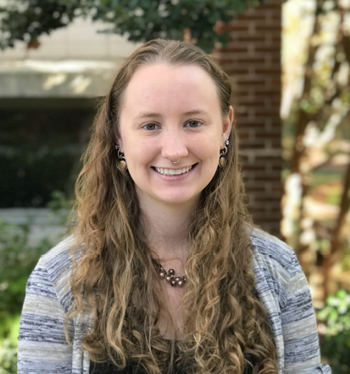 Brianna Tomlinson, 2017-18 CADRE Fellow
Brianna Tomlinson, 2017-18 CADRE Fellow
Educational technologies provide an avenue for engaging students in learning through computer-facilitated experiences. These tools provide opportunities for learners to explore science, technology, engineering, and mathematics (STEM) content in ways they may not otherwise have available (D’Angelo et al., 2014). Simulations are one type of technology which can support interaction while isolating specific concepts as the focus context (Edelson, Gordin, & Pea, 1999). They allow learners to explore hypothetical cases in ways which may not be possible to conduct in real life (J.A. van Berkum & de Jong, 1991).
Even with the potential benefits of use from educational technologies, many barriers exist which prevent learners from fully engaging with them. One of the largest barriers to accessibility is the lack of flexibility in inputs and outputs from their interactions with those technologies. Read more.
Featured Projects
CAREER: Bridging the Digital Accessibility Gap in STEM Using Multisensory Haptic Platforms (PI: Jenna Gorlewicz)
Grades: The content we target in our research has primarily focused on middle school grade levels, but we seek feedback from individuals in middle school up through adulthood.
Target Audience: Individuals with visual impairments
Disciplines/Subject Areas: Multimodal, readily available, digital access to STEM content–both graphics and interactive simulations
With educational content rapidly moving to electronic form, the accessibility gap in STEM is growing–content is and continues to be presented visually. This visual prejudice leaves STEM fields largely inaccessible to the 6 million U.S. K-12 students with disabilities and more specifically, the 678,000 students with blindness or visual impairments (BVI). In this project, we investigate touch-based systems that are readily available for rendering visual STEM content through sight, sound, and touch. We investigate how to use information layering techniques to convey visual information multimodally, and we uncover how touch feedback can support and extend capabilities of visual and auditory feedback. The findings from this work place digital accessibility and inclusion at the forefront of next-generation learning technologies.
Initial Findings: We have been able to establish different touch (vibration) paradigms that are currently being incorporated into a small number of PhET sims toward understanding where tactile feedback can complement and extend the current visual and auditory feedback of the simulations. Building off of our prior work (Award# 1644538) where we have established guidelines for rendering basic graphics multimodally, we are also beginning to understand how to incorporate “drill-down” techniques into more complex graphics to garner more information.
Key Challenge: Individuals with disabilities are often asked to participate in numerous research studies, which can make it challenging for both them and the research team in forming sound, meaningful collaborations. We have taken a very collaborative, and participatory design approach to address this, involving individuals with disabilities early and iteratively throughout the process to realize visions we would have never been able to come up with on our own. It is critical that researchers, especially engineering researchers who have the capability to design amazing technology systems, include individuals with disabilities early in the design and research process, and not just the testing of it, to realize true innovation.
Advice on How to Be More Responsive to Students with Learning or Physical Disabilities: Be aware of learning differences and support student success regardless of whether or not it occurs via traditional media.
How Has COVID-19 and Virtual Learning Positively or Negatively Affected the Student Populations You Work With?: COVID-19 has brought digital learning, with all of its advantages and disadvantages, to the forefront of education. For individuals with visual impairments, remote learning via video-mediated platforms can be quite challenging, as accessibility to content is often overlooked. This research project aims to help us better understand how to produce digital, visual content that is accessible, using tools that are readily available.
Product(s): Publications
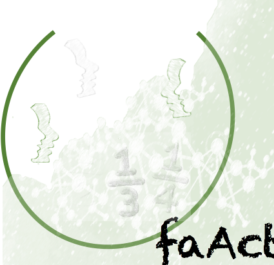 CAREER: Fraction Activities and Assessments for Conceptual Teaching (FAACT) for Students with Learning Disabilities (PI: Jessica Hunt)
CAREER: Fraction Activities and Assessments for Conceptual Teaching (FAACT) for Students with Learning Disabilities (PI: Jessica Hunt)
Grades: 3-5
Target Audience: Students with Learning Disabilities and Math Difficulty; Mathematics Teachers; Special Education Teachers, Researchers.
Disciplines/Subject Areas: Fractions and Rational Numbers; Student-Centered Instruction and Intervention
This project is studying and supporting the development of conceptual understanding of fractions by students with learning disabilities (LD). Rather than focusing on whether students can or cannot develop conceptual understanding, the project is focused on uncovering the complex understanding students DO have and building from students’ strengths via instruction.
Initial Findings: We recently reported on the development and initial testing of an intervention designed to increase access to and advancement in conceptual understanding. Our asset-based theory of change—a tested and confirmed learning trajectory of fraction concepts of students with LDs grounded in student-centered instruction—served as the basis for our multistage scientific design process. We reported on foundational (i.e., a theory of change, establishment and refinement of learning trajectories, and core instructional components) and evaluative (pilot data on student outcomes) components of the intervention. The results of the study reveal positive effects of the program’s fidelity and potential to improve student outcomes in school settings. The positive outcomes support continued exploration and expansion of a new framework for supplemental intervention grounded in trajectories of student learning.
Advice on How to Be More Responsive to Students with Learning or Physical Disabilities:
- Invest time in figuring out how these students understand mathematics and the strengths they bring to instruction.
- Position students as capable by creating an accessible learning environment.
- Use trajectories of student learning to plan and adjust instructional tasks and tools.
- Use responsive pedagogies that (a) Bring forward learners’ prior knowledge, (b) Promote learners’ participation, thinking, and need for change, and (c) Promote learners’ noticing, reflection, connections, and conversation.
Product(s): Project Website | Project Publications & Resources | Citations of Recent Research
Developing Preservice Teachers' Capacity to Teach Students with Learning Disabilities in Algebra I (PI: Casey Hord)
Grades: We are currently working with high school students who have learning disabilities (LD) in mathematics enrolled in Algebra 1, but our project provides findings for working with any student enrolled in Algebra 1 and how to train pre-service teacher how to work with students with LD on Algebra 1 content.
Target Audience: We are targeting other researchers and teacher-educators who work with pre-service teachers on mathematics teaching as well as any secondary school teacher of mathematics.
Disciplines/Subject Areas: Our work sits at the intersection of special education, mathematics education, and cognitive psychology. We focus on how gestures can support working memory and how pre-service teachers can ask questions strategically to both support and challenge students with LD as they engage with Algebra 1.
Project researchers are training pre-service teachers to tutor students with learning disabilities in Algebra 1, combining principles from special education, mathematics education, and cognitive psychology. The trainings emphasize the use of gestures and strategic questioning to support students with learning disabilities and to build students’ understanding in Algebra 1. These trainings will prepare tutors to address the challenges that students with learning disabilities often face—especially challenges related to working memory—and to build on students’ strengths as they engage with Algebra 1.
Initial Findings: We have learned that students with LD benefit from a combination of gestures and strategic questioning. While both of these techniques work in isolation, we are finding that gestures often orient students to important information in problems, or connections between pieces of information, while questions can then be used to challenge the student to think critically. The gestures put the student with LD in position to succeed while questioning can give them opportunities to succeed even further.
Advice on How to Be More Responsive to Students with Learning or Physical Disabilities: It is important to help students with LD show their work in efficient ways on paper and gesture on top of that work to help students make sense of what they have written. This work on paper and gestures can support the working memory of students with LD as they engage with the mathematics and are pressed (as well as supported) to engage further by teachers asking strategic questions. It is important to keep in mind that we want to challenge students with LD with questions that promote their critical thinking, but we also need to keep in mind that students will sometimes struggle and may require some more direct prompting or questioning that guides them when they are experiencing difficulties and potential math anxiety.
Learn more: Project Website | Previous Research | Publications
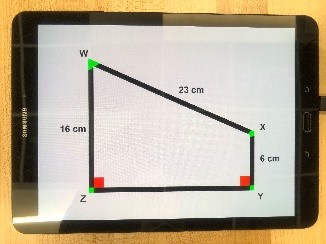 Perceptual and Implementation Strategies for Knowledge Acquisition of Digital Tactile Graphics for Blind and Visually Impaired Students (PIs: Nicholas Giudice, Jenna Gorlewicz, Derrick Smith, and Andreas Stefik)
Perceptual and Implementation Strategies for Knowledge Acquisition of Digital Tactile Graphics for Blind and Visually Impaired Students (PIs: Nicholas Giudice, Jenna Gorlewicz, Derrick Smith, and Andreas Stefik)
Grades: The content we target in our research has primarily focused on middle school grade levels, but we seek feedback from individuals in middle school up through adulthood.
Target Audience: Individuals with visual impairments
Disciplines/Subject Areas: Multimodal, readily available, digital access to STEM graphics
This project lays the foundation and framework for enabling presentation of digital, multimodal tactile graphics on touchscreens for individuals with visual impairments (VI). Given the low-cost, portability, and wide availability of touchscreens, this work promotes the use of vibrations and sounds on these commercially-available platforms for addressing the graphical access challenge for individuals with VI. An open-source vibration library has been created and fundamental perceptual building blocks (e.g., shapes, lines, critical points, line width and gaps, etc.) guiding how basic graphical components should be rendered on these platforms is being disseminated.
Initial Findings: We have been able to demonstrate that vibrations, sounds, and speech feedback can support the exploration of graphics displayed on touchscreens. We’ve determined how to render lines, shapes, and basic data representations (e.g., bar charts). We have demonstrated that individuals can explore and answer questions about the renderings with equal accuracy to that of embossed graphics, often considered the gold standard for tactile representations. We are also beginning to understand how to incorporate “drill-down” techniques into graphics to gain more information, and how to layer the multimodal feedback in meaningful ways. Compared to traditional hardcopy output, our system has the advantages of being multimodal, refreshable, and produced on inexpensive commercially available hardware, enhancing the potential opportunity for adoption and scalability.
Key Challenge: It is critical that research such as this is done collaboratively with the targeted end users being integral members and contributors of the research. This iterative nature can be challenging in terms of scoping and planning a project but results in far more impactful research outcomes.
How Has COVID-19 and Virtual Learning Positively or Negatively Affected the Student Populations You Work With?: COVID-19 has brought digital learning, with all of its advantages and disadvantages, to the forefront of education. For individuals with visual impairments, remote learning via video-mediated platforms can be quite challenging, as accessibility to content is often overlooked. This research project aims to help us better understand how to produce digital, visual content that is accessible, using tools that are readily available.
Learn more: Quorum Language Website | Open-Source Vibration Library | Project Publications & Resources | Citations of Recent Research
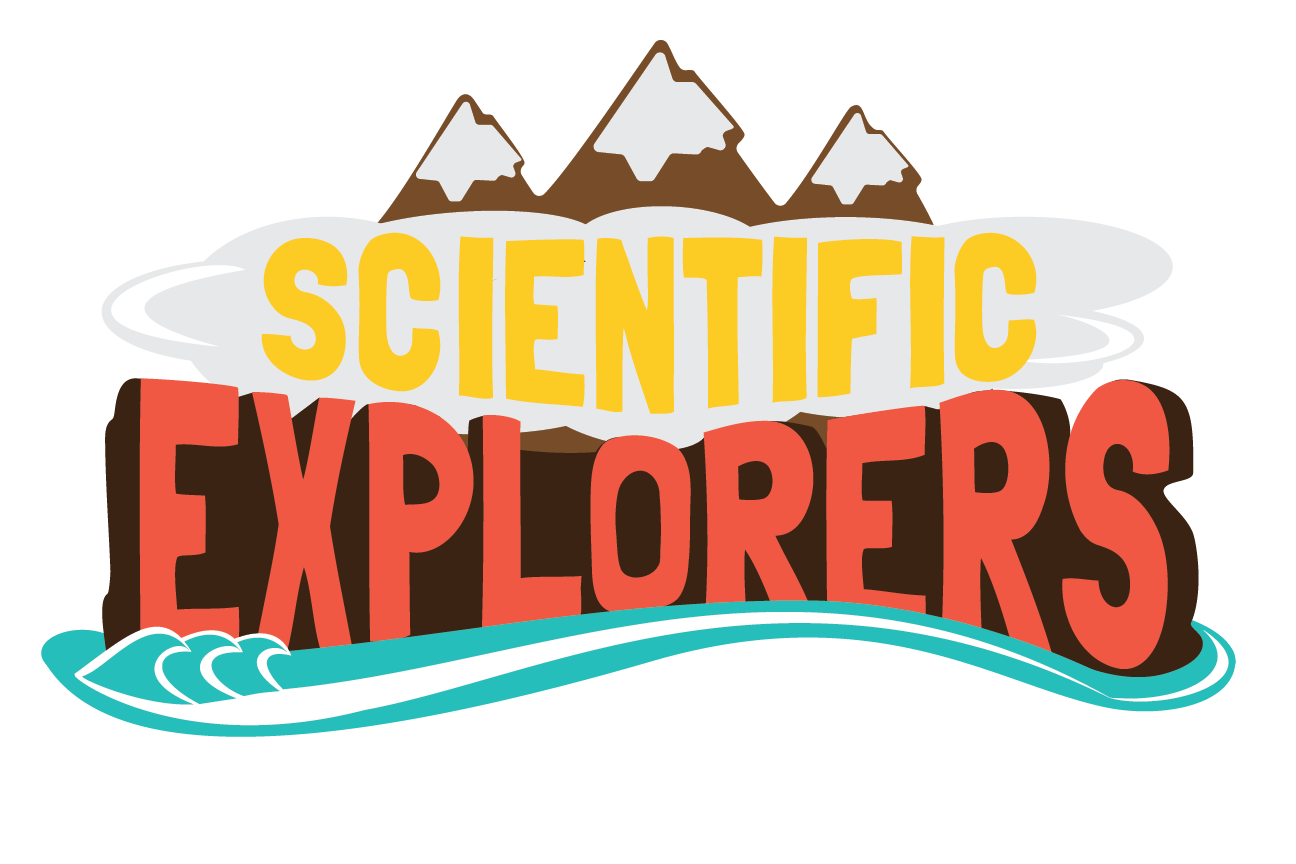 Promoting Scientific Explorers Among Students with Learning Disabilities: The Design and Testing of a Grade 2 Science Program Focused on Earth’s Systems (PI: Christian Doabler)
Promoting Scientific Explorers Among Students with Learning Disabilities: The Design and Testing of a Grade 2 Science Program Focused on Earth’s Systems (PI: Christian Doabler)
Grade: 2
Target Audience: The Scientific Explorers (Sci2) program targets the full range of second-grade students, including students with or at risk for learning disabilities.
Disciplines/Subject Areas: The Sci2 program is a whole-class science program aimed at promoting students’ understanding and application of the disciplinary core ideas, cross-cutting concepts, and practices associated with Earth’s Systems in the Next Generation Science Standards (NGSS). Grounded in a framework of guided inquiry instruction, the Sci2 program is comprised of hands-on and simulation-based investigations focused on how natural phenomena, such as wind and water, can change the shape of the Earth, and how such processes, which can occur rapidly or over longer periods of time, affect humans and animals.
Few effective instructional tools exist for the elementary science classroom to promote a deep and robust understanding of early science concepts. Therefore, the primary aim of this project was to design a second-grade science program focused on Earth’s systems. To support the full range of learners, including those with learning difficulties, the Sci2 program includes hands-on and simulation-based investigations. Recognizing the important role of early literacy and mathematics in science learning, the program integrates core disciplinary ideas in science with critical mathematics and literacy standards. To support all students in science-related tasks, our project incorporated validated principles of instruction into the Sci2 program’s lessons. Specifically, the program centers on a framework of guided inquiry instruction. Another aim of this project was to develop and empirically validate science assessments that measure students' knowledge and application of core science concepts and practices related to Earth's systems.
Instruments: In the Sci2 project, we developed a battery of student outcome measures as well as direct observation measures and teacher surveys. Similar to other studies, we faced a paucity of validated measures in early science learning and therefore capitalized on the opportunity to contribute to the development of early science assessments. We grounded the three measures in the science learning expectations specified in the Next Generation Science Standards (2013). The three measures include the Virtual Investigation of Science Practices Assessment (VISPA; Doabler et al., 2019), the Test of Early Geoscience Learning (TEGL; Doabler et al., 2019), and the Measure of Science Vocabulary Knowledge (SEVA).
The VISPA is a 6-item, individually administered, tablet-based assessment that purports to measure students’ application and understanding of the NGSS (2013) science and engineering practices. Comprised of a simulated investigation focused on Earth’s Systems in the second-grade NGSS (2013), the VISPA has students interact with a virtual character to (a) plan and conduct a scientific investigation on wind erosion, (b) interpret the investigation’s results, and (c) communicate the findings of the research. The reported coefficient for Cronbach’s alpha was .53 and test-retest reliability was .44.
The TEGL is a group-administered measure that assesses students’ understanding of Earth processes, such as weathering and erosion, identified in the second-grade NGSS core idea of Earth’s Systems. The TEGL represents a 20-item assessment comprised of 17 multiple-choice items and 3 short answer questions. IRT-based test reliability indicate that reliability was above .70 for ability levels ranging from -2.80 to 0.60. The coefficient for Cronbach’s alpha was .71. Test-retest reliability on this sample was .63.
The SEVA is an individually administered expressive-definitions vocabulary measure that requires students to orally define key science vocabulary terms taught in the Sci2 program and directly related to Earth’s Systems in the NGSS (2013). For example, assessors ask students to provide a definition of erosion (e.g., “What does the word erosion mean?”). The reported coefficient for Cronbach’s alpha was .76 and test-retest reliability was .65.
Additionally, we developed a direct observation protocol to document aspects of implementation fidelity, instructional quality, and targeted science content. The fidelity of implementation aspect of the observation tool maps directly onto the lesson structure and core components of the Sci2 program. We also developed and administered a teacher survey prior to the start of our pilot study. The survey documented demographic information including race, ethnicity, age, gender, teaching experience, education, and possible areas of specialization, including geoscience backgrounds.
Initial Findings: In a recent randomized controlled trial (Doabler et al., 2021), we investigated the initial efficacy of the Scientific Explorers (Sci2) program. A total of 18 second-grade classrooms with nearly 300 students participated in the study. Classrooms were randomly assigned to either treatment or control conditions. Treatment classrooms implemented the Sci2 program, while control classrooms used business-as-usual science instructional practices and materials. Overall, findings suggested "promise” of the program to increase student science achievement. Treatment effects were observed on three of four science outcome measures. The reported effects were moderate to large, with effect sizes (Hedges’ g) ranging from .48 to .94. Results indicated a small (g = .02), non-significant effect on the fourth outcome measure. Moderation analyses indicated that science knowledge at pretest did not moderate Sci2’s effects. Thus, the program offered a non-different effect regardless of pretest science knowledge.
Key Challenge: Throughout this DRK-12 project, we encountered three main challenges:
- One primary challenge was developing feasible hands-on investigations that could be implemented in second-grade classrooms with minimal preparation and clean up for end-users (i.e., teachers and students). For example, given our content area of Earth’s Systems, we had to figure out how to incorporate the role of water and wind in a practical and effective way. Facing this challenge, we decided to incorporate simulation-based activities, which not only proved to be a solution, but also a potential boon. Without simulation-based investigations, opportunities to work with early science concepts (e.g., erosion in the mountains) and engineering practices (e.g., designing solutions to address human problems) in the field would be limited for many students given safety concerns, cost, time, and access to remote geographic locations. Simulation-based learning, therefore, may help bridge science achievement gaps by providing enriching science experiences to struggling learners and those students from marginalized and underserved communities.
- Another challenge faced was the paucity of empirically-validated student outcome measures for early science learning. As such, we developed three outcome measures and grounded them in the science learning expectations specified in the Next Generation Science Standards (2013).
- Lastly, we found that there was limited time for implementing our program in today’s classrooms. From our implementation studies, we recognized that science instruction in early elementary grades is often not prioritized, which posed implications for how often and for how long we could implement our program. To address these time issues, we provided teachers with a list that identified mandatory and optional core components for each lesson. We chose the mandatory components based on what was essential and indispensable for increasing student science achievement.
Advice on How to Be More Responsive to Students with Learning or Physical Disabilities: To support all students, including those with or at risk for learning disabilities, we recommend that teachers incorporate principles of guided inquiry instruction into their daily science instruction. By this, we strongly recommend teachers provide students with clear explanations of targeted science content, offer well-designed opportunities for students to practice with and engage in such content, and deliver timely academic feedback to affirm student learning and address potential misconceptions. In addition, to build students’ background knowledge and promote a high rate of student success, we advise teachers to pre-teach important information such as key vocabulary terms. Relatedly, we contend integrating hands-on and simulation-based investigations promotes meaningful opportunities for students to develop conceptual knowledge and transfer such understanding to novel, real-world contexts. Finally, we recommend teachers model and demonstrate how to engage in science-related discourse, such as communicating findings garnered by investigations. In these discussions, we suggest teachers provide adequate “think time,” allow opportunities for students to interact with their peers, and include different perspectives to promote diverse points of view.
How Has COVID-19 and Virtual Learning Positively or Negatively Affected the Student Populations You Work With?: While our pilot study concluded just prior to the onset of the COVID-19 pandemic, based on our experience in working in U.S. classrooms, we contend the shift to remote learning has had mixed effects on teachers and students. For some, the transition has had little impact. However, for many, particularly children from marginalized and underserved communities, COVID-19 has imposed devastating effects on their content learning. Unfortunately, virtual learning has deprived these children access to the critical investigations and problem-solving scenarios that are necessary for subsequent learning in the areas of STEM. For example, because teachers were forced to reconceptualize their classroom management techniques to accommodate live synchronous sessions, students engage in discourse via novel formats, such as through chat functions, breakout rooms, and full class share outs. This shift in response opportunities likely only exacerbates a lack of participation among students who demonstrate low self-confidence and face learning difficulties. Other limitations include at-risk learners having little access to individualized instruction and opportunities to interact with their typically-achieving peers.
Products: Website | Publications | Presentations
Strengthening Mathematics Intervention: Identifying and Addressing Challenges to Improve Instruction for Struggling Learners (PI: Amy Brodesky)
Grades: 5-8
Target Audience: Teachers of mathematics intervention classes for grades 5-8. These intervention classes provide additional instruction and targeted support for students who are struggling with mathematics, including learners with disabilities.
Disciplines/Subject Areas: The project focuses on key mathematics content in fractions, decimals, integers and expressions and equations to build students’ foundational knowledge for success with the middle grades standards.
The project’s main goals are: 1) to study the current landscape of mathematics intervention classes at the middle grades, and 2) to create a professional development (PD) program to strengthen intervention teachers’ abilities to provide effective instruction to students struggling with mathematics. To study intervention practices (goal 1), we conducted classroom observations, interviewed teachers and leaders, and surveyed a nationally representative sample of public schools with grades 6-8. The national survey findings revealed widespread implementation of mathematics intervention classes (69% of schools) with variation in class size, scheduling, staffing, and practices (n: 876 schools). We applied the survey findings to design two blended PD courses specifically for teachers of mathematics intervention classes (goal 2). In the PD, teachers build their ability to: 1) use evidence-based intervention practices; 2) gather, analyze, and apply formative assessment data; and 3) plan and teach lessons that are targeted to their students’ strengths and needs.
Instruments: For the studies, we used a combination of existing instrument and project-developed instruments. Because there are few existing instruments that focus on mathematics intervention classes at the middle grades, we needed to design several instruments for this specific context.
Existing Instruments:
For the Pilot Study of the SMI PD course, we used the following existing instruments to collect pre-post data on teachers’ knowledge, self-efficacy, and beliefs:
- Mathematics knowledge for teaching: Learning Mathematics for Teaching Instrument (LMT, 2011)
- Self-efficacy: Mathematics Teaching Self Efficacy Scale (MTSES; Wilhelm & Berebitsky, 2017). We received permission from the instrument authors to change the wording of some items to refer specifically to “mathematics intervention classes.”
- Beliefs about learning and teaching mathematics: Mathematics Mindset Beliefs Items (Sun, 2015)
Project-Developed Instruments:
For the national survey on math intervention classes and the pilot study of the SMI PD course, we needed to create new instruments because there are few existing measures that focus specifically on mathematics intervention at the middle grades.
For the national survey, we created a survey instrument to focus on mathematics intervention at the middle grades. We first conducted interviews and classroom observations to inform the development of the survey items. We conducted cognitive interviews on the survey items, piloted them with teachers, and refined them. National Survey on Supporting Struggling Mathematics Learners in the Middle Grades (Zweig, Brodesky, Fagan, Hirsch, & Karp, 2016)
For the pilot study of the SMI PD course, we adapted instruments from prior NSF-funded projects, which focused on improving instruction for students with mathematics difficulties/disabilities in general education mathematics classes. We revised the instruments to focus specifically on mathematics intervention classes. For the survey of instructional practices, we added practices that are recommended for intervention classes as well as others that we had observed during classroom observations in order to capture a range of possible practices that teachers might use. The two instruments are Preparedness for Teaching Students with Mathematics Difficulties and an Instructional Practices Survey for Mathematics Intervention Classes.
Initial Findings: In this section, we briefly describe findings from two studies: 1) national survey on mathematics intervention practices and 2) pilot study of a Strengthening Mathematics Intervention PD course.
National Survey Findings
Prior to our project’s study, there was little information available about the national landscape of mathematics intervention practices at the middle grades. To address this gap in the field, we designed and administered an online survey to a nationally representative sample of 2,024 U.S. public schools with grades 6-8 (in 2017). Approximately 43% of schools (876 schools) responded to the survey, with one respondent per school. The findings revealed the widespread implementation of mathematics intervention classes. About 69% of schools provided math intervention classes in grades 6, 7, or 8, with 56% providing them in all three grades (2016-2017 school year). For the schools with math intervention classes (n: 609), the most frequently reported scheduling method was to have students attend these classes instead of a non-core subject, such as an elective (51%), followed by having a designated time in the schedule where all students took either an intervention or an enrichment class (38%). About 51% of schools reported that these classes had between 6 and 15 students. The most common class lengths were 40–49 minutes (43% of schools) following by 50–59 minutes (26%). Nearly half of the schools reported that their math intervention classes met five days a week and about 40% met two or three days a week. The vast majority of schools (85%) reported that MI classes were taught by a staff member with a mathematics-specific role (e.g., mathematics interventionist, mathematics teacher, mathematics coach). The three most commonly reported challenges were: 1) students in intervention classes have a wide range of learning needs; 2) students have negative attitudes towards being in mathematics intervention classes; and 3) more students need mathematics intervention classes than schools are able to serve. The Executive Summary provides additional survey findings about how schools identify students for mathematics intervention classes, staffing, goals, approaches, and challenges.
Pilot Study Findings for the SMI PD Course
The pilot study was designed to investigate the research question: After participating in the SMI PD course, to what extent do teachers show increases in their knowledge, practices, and self-efficacy for teaching students in mathematics intervention classes? The sample was twenty-eight educators from MA and ME districts who completed the full course (70 PD hours across one school year). The course’s blended format included five face-to-face sessions (full-day), five online sessions (each 4-5 weeks long), four 1-hour virtual meetings for small groups of teachers, and classroom assignments to apply ideas with students. The research team administered pre-and-post instruments and produced descriptive statistics and frequencies to describe the knowledge, goals, beliefs, and practices of participants before and after participating in the SMI PD course. They also used statistical tests, such as paired t-tests, to understand the extent to which there were changes from pre-to-post course. After participating in the SMI course, educators showed increases in mathematics content knowledge, self-efficacy, and reported use of instructional practices. These findings suggest that the course shows promise for having a positive impact on educators’ abilities to teach students with mathematics difficulties in intervention classes. In considering the findings, it is important to keep two limitations in mind: the sample was small; and some data were based on participants' self-report of instructional practices and self-efficacy.
Advice on How to Be More Responsive to Students with Learning or Physical Disabilities: Teachers may feel overwhelmed or unsure about to best use their limited intervention time to help students who struggle with mathematics. In our SMI PD courses, our goal is to help teachers shift from deficit models to strength-based approaches for supporting students with mathematics difficulties and disabilities in intervention classes. We focus on using formative assessment approaches to help teachers uncover information about their students’ understandings and challenges and provide targeted instruction that builds on strengths. Teachers learn to use formative assessment probes in paper-pencil formats, as card-sorts, and for interviewing students. The probes are designed to uncover evidence of understandings, difficulties, or potential misconceptions for specific mathematics topics.
We also emphasize using robust tasks with accessible entryways and instructional strategies to actively engage students in doing mathematics and talking about their ideas. But using engaging mathematics activities is not necessarily enough to get students talking. Students who struggle with mathematics are often hesitant to speak up in their general education mathematics classes. Mathematics intervention classes can provide a smaller, safer space for students to communicate their ideas and ask questions, building their confidence for participating in other classes. In the PD, teachers learn about and use language strategies, such as sentence frames and discussion protocols for card sorts, to promote student communication. Teachers also work on writing lesson learning goals that include clear success criteria and communicating them in student-friendly language. Using these goals with students throughout a lesson, helps students gain more clarity on expectations, self-assess their progress, and become more self-regulated in their learning.
Teachers in the PD benefit from opportunities to strengthen and expand their repertoires of evidence-based instructional strategies, including using manipulatives, visual representations, number line representations, and connecting concrete, semi-concrete, and abstract representations. The PD provides mathematics activities that incorporate the approaches for teachers to first explore as learners themselves and then to apply with students in intervention classes.
Key Challenge: One challenge for our research and development is that there is a lot of variation in how schools implement mathematics intervention classes, much more so than for general education mathematics classes. By doing an observational study with classroom visits and interviews, we learned firsthand about schools’ different goals, structures, and practices for their implementation classes. For the national survey, we needed to clearly define what mathematics intervention classes are and are not in order to gather information on the prevalence of these classes. We defined mathematics intervention classes as classes that schools provide in addition to general education classes and during the school day. These classes are different from separate special education mathematics classes, study halls, or afterschool tutoring. Using our established definition of mathematics intervention classes, we screened applications for the SMI PD courses to identify teachers who fit our target audience. Even among the selected participants there was a lot of variation in their intervention classes, including class length, frequency, duration, and class sizes. For the PD courses, we strove to design activities and resources that would be relevant and applicable for teachers working in these varied intervention class contexts. Drawing on these experiences, we recommend that projects clearly define what models of mathematics intervention they will focus on in research studies and gather data on teachers’ intervention contexts and professional learning needs to inform the design of PD programs.
Products: Project Website | National Survey on Supporting Struggling Mathematics Learners in the Middle Grades: Executive Summary and Survey Instrument | Publications | Accessibility Strategies | Accessibility Planners | Formative Assessment Probes
Resources
- Dissemination Toolkit: Accessible Products and Communications | CADRE
- Edtech Resources for Special Education Practioners | IES Webinar Recap
- Strengthening Educators’ Practices for Engaging and Empowering Students with Disabilities and Difficulties as Mathematics Learners webinar, led by presenters Amy Brodesky, Jessica Hunt, Karen Mutch-Jones and Judy Storeygard | CADRE
- Supporting Students with Disabilities | CCSSO
- The Condition of Education: Students with Disabilities | IES NCES
- The UDL Guidelines | CAST
- Theme of the Month: Including Individuals with Disabilities in STEM Courses, Research, and Careers | Multiplex
Additional Projects
In addition to those featured above, the following projects provide a sample of DRK-12 work related to supporting students with disabilities.
2020 Awards
- Enhancing Rational Number Instruction for Students with Math Disabilities and Difficulties: Designing Professional Development for Teachers Who Provide Math Intervention (PI: Russell Gersten)
- Leveraging Simulations in Preservice Preparation to Improve Mathematics Teaching for Students with Disabilities (Collaborative Research) (PIs: Julie Cohen and Nathan Jones)
2018 Awards
- Accelerating Higher Order Thinking and STEM Content Learning Among Students with Learning Disabilities (PI: Jose Blackorby)
- Highly Adaptive Science Simulations for Accessible STEM Education (PI: Emily Moore)
2017 Awards
- Measuring Early Mathematical Reasoning Skills: Developing Tests of Numeric Relational Reasoning and Spatial Reasoning (PI: Leanne Ketterlin Geller) | Learn more: Project Website
- Project MAPLE: MAkerspaces Promoting Learning and Engagement (PI: Jeffrey Ginger)
2016 Awards
- Algebraic Learning and Cognition in Learning Disabled Students (PI: David Geary)
- Sonified Interactive Simulations for Accessible Middle School STEM (PI: Emily Moore) | Learn more: Video (2017)
2015 Awards
- Conceptual Model-based Problem Solving: A Response to Intervention Program for Students with Learning Difficulties in Mathematics (PI: Yan Ping Xin) | Learn more: Video (2017)
- Ramping Up Accessibility in STEM: Inclusively Designed Simulations for Diverse Learners (PI: Emily Moore) | Learn more: Video (2016)
2014 Awards
- Reclaiming Access to Inquiry-based Science Education (RAISE) for Incarcerated Students (PI: Michael Krezmien)| Learn more: Video (2018)
RELATED SPOTLIGHT
Broadening Participation in STEM
